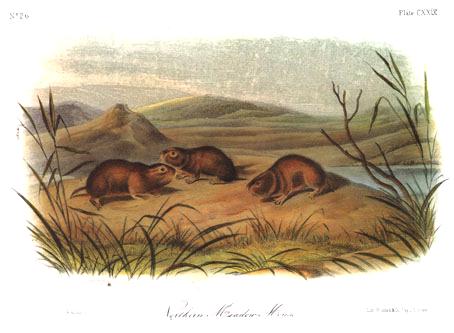

129 Northern Meadow Mouse
ARVICOLA BOREALIS.--RICH.
[Phenacomys intermedius]
NORTHERN MEADOW-MOUSE.
[Heather Vole]
PLATE CXXIX.--MALE and FEMALES.
A. ungue pollicari robusto praeditus, auriculis vellere absconditis, cauda
capitis fere longitudine, vellere longissima molli, dorso castaneo nigro mixto,
ventre cano.
CHARACTERS.
Thumb nail, strong; ears, concealed in the fur; tail, about as long as the
head; fur, very long and fine; on the back, chestnut colour mixed with black; on
the belly, gray.
SYNONYMES.
MOUSE No. 15. Forster, Philos. Trans., vol. lxii. p. 380.
ARVICOLA BOREALIS. Rich., Zool. Jour., No. 12, April, 1828, p. 517.
ARVICOLA BOREALIS, NORTHERN MEADOW-MOUSE. Rich, F. B. A., p. 127.
ARVINNAK. Dog-Rib Indians.
DESCRIPTION.
This species is a little less than WILSON's Meadow-Mouse (A.
Pennsylvanica). It has the form and dentition of the other species of
Arvicolae. Head, rather large; forehead, convex; nose, short, and a little
pointed; eyes, small; ears, low, rounded, and concealed by the surrounding fur;
limbs, rather robust, clothed with short hairs, mixed on the toes and hind parts
of the fore feet with longer hairs. Hind toes, more slender, and scarcely
longer than the fore ones; fore claws, small, much compressed, arched, and
acute, with a narrow elliptical excavation underneath; the hairs of the toes
reach to the points of the nails, but cover them rather sparingly; the claws of
the hind feet resemble those of the fore feet, but are not so strong; the thumb
of the fore feet consists of a small squarish nail slightly convex on both
sides, and having an obtuse point projecting from the middle of its extremity;
the tail is round, well clothed with short stiff hairs running to a point, which
do not permit the scales to be visible. There are considerable variations in
the length of the tail, it being in one specimen a third longer than in others.
The fur on the body is long in proportion to the size of the animal.
COLOUR.
Hair on the upper parts blackish-gray from the roots to the tips, some of
which are yellowish or chestnut brown, and some black; the black tipped hairs
are the longest, and are equally distributed amongst the others, giving the body
a dark reddish-brown colour. There is a rufous patch under the ears. On the
under part, and on the chin and lips, the colour is lead-gray, and the hairs are
shorter than on the back and sides; tail, brown above and grayish beneath; hairs
on the feet, ochreous yellow; claws, white.
DIMENSIONS.
Inches. Lines.
Length of head and body,. . . . . . . . 4 6
Length of tail,. . . . . . . . . . . 1 0
Length of head,. . . . . . . . . . . 1 3
Height of ear, . . . . . . . . . . . 0 4
Breadth of ear,. . . . . . . . . . . 0 3
Length of fore feet to end of middle claw,. . 0 4 1/2
Hind feet, including heel and claw, . . . . 0 7 1/2
Fur on the back, . . . . . . . . . . 0 10
HABITS.
We have little to say in regard to the present species. RICHARDSON states
that its habits are very similar to those of A. xanthognatha, and in our article
on that species we have given an account of the general habits of the Arvicolae
(at p. 18 of the present volume), to which we refer our readers.
The northern Arvicolae do not appear to become dormant from the effect of
cold, but during the long Arctic winter dig galleries under the deep snows, in
which they are enabled to search for seeds, grasses, or roots suited to their
wants. We have ascertained by an examination of the bodies of several, more
southern species of Arvicolae, possessing similar habits, that so far from
suffering in winter and becoming lean, they are usually in good case, and
sometimes quite fat, during that season.
The length of the fur on the back of the present species (ten twelfths of
an inch) is somewhat remarkable for so small an animal.
GEOGRAPHICAL DISTRIBUTION.
This species was found in numbers at Great Bear Lake, living in the
vicinity of Arvicola xanthognatha. We have not been able to ascertain the
extent of its range towards the south or west. We did not discover this
Meadow-Mouse or hear of it on our expedition to the Yellow Stone and Upper
Missouri rivers, nor has it been found, so far as we know, anywhere west of the
Rocky Mountains.
GENERAL REMARKS.
"The form of the thumb-nail allies this animal very closely to the Norway
lemming, and to one or two species of American lemming, but its claws are
smaller and more compressed, and apparently not so well calculated for scraping
earth as the broader claws of the lemmings."--Fauna Boreali Americana, p. 127.
Thus far we agree with Dr. RICHARDSON; he, however, thinks that this
species may be considered an intermediate link between the lemmings and the
Meadow-Mice, and may without impropriety be ranked either as a true Meadow-Mouse
or as a lemming.
After a careful examination of the original specimens, some years ago, we
set it down as a true Arvicola, possessing more of the characteristics of that
genus than of the genus Georychus.
|